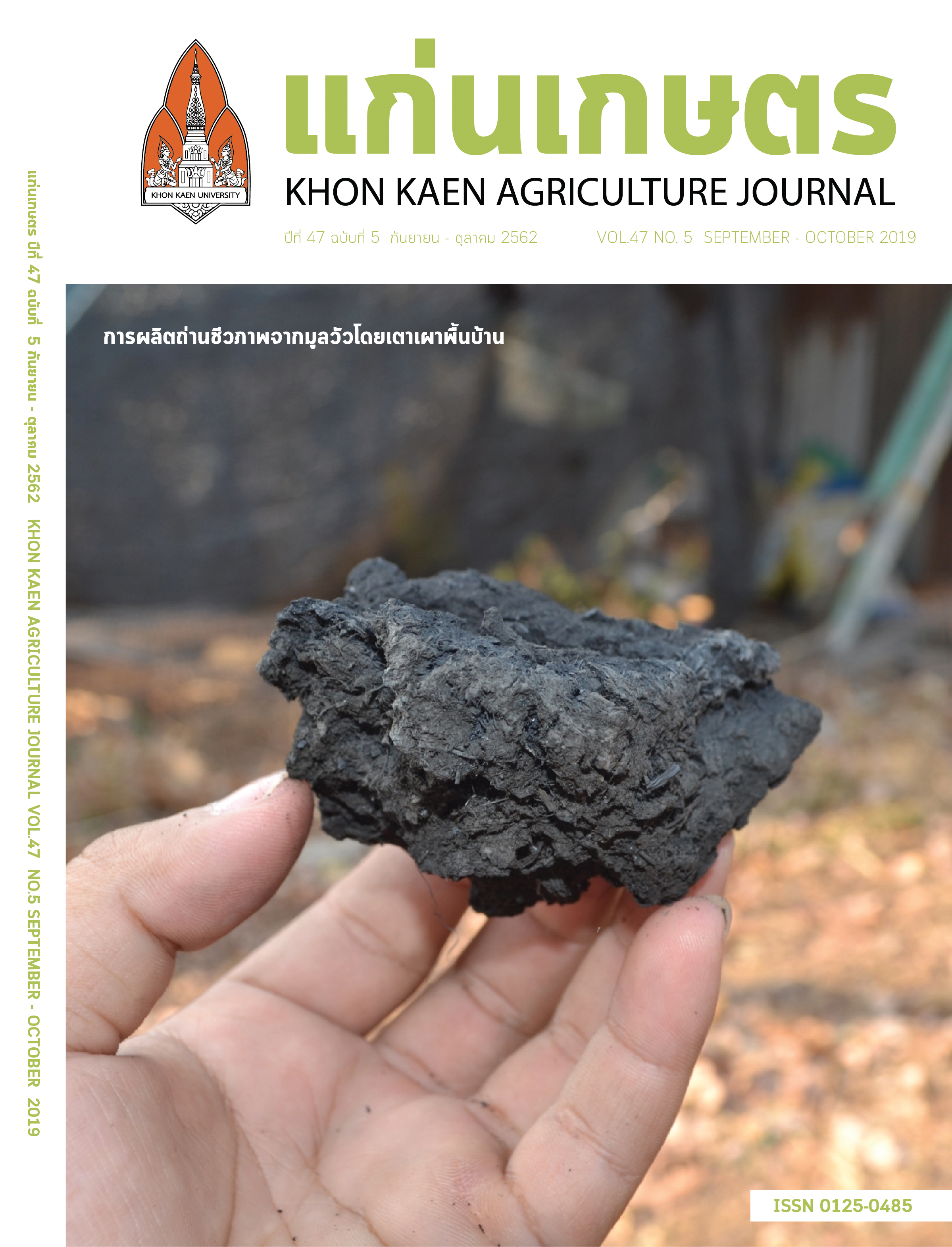ความดีเด่นของข้าวลูกผสมเซบั้งไฟ 1 ภายใต้สภาพปกติและสภาพแล้งในระยะการเจริญเติบโตช่วงสืบพันธุ์
Main Article Content
บทคัดย่อ
พันธุ์ข้าวเซบั้งไฟ 1 เป็นข้าวเหนียว นิยมปลูกอย่างแพร่หลายในสาธารณรัฐประชาธิปไตย ประชาชนลาว เนื่องจากมีคุณภาพการหุงต้มดี และให้ผลผลิตสูง นอกจากนี้ยังทนทานต่อน้ำท่วมฉับพลัน แต่ยังมีข้อจำกัดในเรื่องความอ่อนแอต่อสภาพแล้ง การศึกษาครั้งนี้มีวัตถุประสงค์ เพื่อประเมินความดีเด่นของลูกผสม ในลักษณะผลผลิตและความทนแล้ง โดยใช้พันธุ์ข้าวเซบั้งไฟ 1 เป็นพันธุ์พ่อ และข้าวไร่พันธุ์พื้นเมืองของไทยที่มีรายงานความทนทานต่อสภาพความแล้งจำนวน 5 พันธุ์ ได้แก่ ULR 113, ULR 199, ULR 012, ULR 125 และ ULR 007 เป็นพันธุ์แม่ จากการศึกษาความดีเด่นของลูกผสมทั้ง 5 คู่ผสมในสภาพปกติและสภาพแล้ง พบว่าคู่ผสมระหว่างข้าวพันธุ์ ULR199 และพันธุ์ข้าวเซบั้งไฟ 1 ให้ค่าความดีเด่น Mid-parent heterosis (MH) และ Better-parent heterosis (BH) ในสภาพแล้งของลักษณะผลผลิตทั้งหมดสูงกว่าคู่ผสมอื่นๆ (MH = 221.2**, BH = 168.6**) นอกจากนี้ยังให้ค่า Mid-parent heterosis (MH) และ Better-parent heterosis (BH) ในสภาพแล้งของลักษณะการม้วนใบ (MH = -22.66*,-32.69*) และใบตาย (MH = -21.4*,-32.5*) ที่ต่ำกว่าคู่ผสมอื่นๆ จึงเป็นคู่ผสมที่ดีที่สุด นอกจากนี้พบว่าเมื่ออยู่ในสภาพแล้งผลผลิตมีสหสัมพันธ์เชิงบวก กับลักษณะทางการเกษตร เช่น เปอร์เซ็นต์เมล็ดดี (r = 0.91**), น้ำหนัก 100 เมล็ด (r = 0.72**), ความยาวรวง (r = 0.76**), จำนวนเมล็ดต่อรวง (r = 0.73**), จำนวนหน่อต่อกอ (r = 0.76**), จำนวนรวงต่อกอ (r = 0.73**), มวลชีวภาพ (r = 0.90**), น้ำหนักแห้งราก (r = 0.82**), การฟื้นตัวข้าวอายุ 92 วัน (r = 0.77**) และค่าดัชนีเก็บเกี่ยว (r = 0.91**) แต่ผลผลิตเมล็ดในสภาพแล้ง มีค่าสหสัมพันธ์ทางลบกับลักษณะเปอร์เซ็นต์เมล็ดลีบ (r = -0.90**), คะแนนใบตาย (r = -0.46**), คะแนนม้วนใบ (r = -0.46**) และค่าศักย์ของน้ำในข้าวอายุ 79 วัน (r = -0.48**) ซึ่งค่าสัมประสิทธิ์ของสายสัมพันธ์เหล่านี้สามารถนำมาใช้เป็นลักษณะในการคัดเลือกข้าวทนแล้งได้.
Article Details
เอกสารอ้างอิง
De Datta, S.K., Malabuyoc, J.A., and Aragon, E.L. 1988. A field screening technique for evaluating rice germplasm for drought tolerance during the vegetative stress. Field Crops Research. 19: 123-134.
Fukai, S., and Ouk, M. 2012. Increased productivity of rainfed lowland rice cropping systems of the Mekong region. Crop and Pasture Science. 63: 944-973.
Guimarães, C. M., StoneI, L. F., Rangel, P. H. N., and Silva., A. C. de L. 2013. Tolerance of upland rice genotypes to water deficit. Revista Brasileira de Engenharia Agrícolae Ambiental. 17: 805–810.
Gomez, K.A., and Gomez, A.A. 1984. Statistical procedures for agricultural research (2 ed.). John Wiley and Sons, New York. 680.
IRRI. 1996. Standard Evaluation System for Rice. The International Rice Research Institute. Manila Philippines. 24: 1-16
Lanceras, J.C., G. Pantuwan, B. Jongdee and T. Toojinda. 2004. Quantitative trait loci associated with drought tolerance at reproductive stage in rice. Plant Physiology 135: 1-16.
Mambani, B., and Lal, R. 1983. Response of upland rice varieties to drought stress II. Screening rice varieties by means of variable moisture regimes along a toposequence. Plant and Soil. 73: 73-94.
Narenoot, K., Monkham ,T., Chankaew ,S., Songsri, P., Pattanagul, W., and Sanitchon, J. 2015. Evaluation of the tolerance of Thai indigenous upland rice germplasm to early drought stress using multiple selection criteria. Plant Genetic Resources: Characterization and Utilization, 15: 109 – 118.
Pantuwan, G., Fukai, S., Cooper, M., Rajatasereekul, S., J.C. and O’Toole. 2002. Yield response of rice (Oryza sativar L.) genotypes to different type of drought under rainfed lowlands part 1. 73: 153-168.
Pharwong, J., Jongdee, B., Panwan, G., and Laohasiriwong, S. 2555. Validation for drought tolerance genotypes in SURIN1 backcross introgression lines. Khon Kaen Agricultural Journal. 40: 229-236.
Pandey, V., and Shukla,. A. 2015. Acclimation and Tolerance Strategies of Rice under Drought Stress Volume 22, Issue 4, July 2015, P.147-161
Saini, S.S., Kumar, I. and Gagneja,M.R.1974. A study on heterosis in rice (Oryza sativ L.).Euphytica 23:219-224.Soehendi, R. and Srinives, P., 2005. Significance of heterosis and heterobeltiosis in an F1 hybrid of mungbean Vigna radiata (L.) Wilczek for hybrid seed production. SABRAO Journal. of Breeding. and Genetics. 37,97-105.
Steel, R.G.D., and Torrie., J.H. 1980. Principles and Proceedures of Statistics: A Biometrical Approach, Inc., New York, USA. 633.
Tiwari, D.K., Pandey, P., Giri,S.P., and Dwivedi, J.L. 2011,Heterosis studies for yield and tis components in rice hybrids using CMS system, Asian Journal of Plant Sciences 10(1):29-42.
Virmani, S.S., Hossain, M., and Bayarsaihan, T. Eds. 2006. Policy support needs of hybrid rice technology in Asia. 82: 7-12.
Wassmann R, Jagadish S. V. K., Sumfleth, K., Pathak, H., Howell, G., Ismail, A., Serraj, R., Redona, E., Singh, R K., and Heuer, S. 2009. Regional vulnerability of climate change impacts on Asian rice production and scope for adaptation. 102: 91-133.
Wopereis, M.C.S., Kropff, M.J., Maligaya, A.R., and Tuong, T.P. 1996. Drought-stress responses of two lowland rice cultivar to soil water status. Field Crops Research. 46: 21-39.
Xangsayasane, P., Inthapanya, P., Thavonsouk, N. 2012. Challenge of increasing rice productivity in flood prone areas of Xebangfai flood plain. The Lao Journal of Agriculture and Forestry. 65.
Yang-Ying, QU., Mu, P., Li, X.Q., Tian, Y.X., Wen, F., Zhang, H.L., and Li, Z.C. 2008. QTL Mapping and correlations between leaf water potential and drought resistance in rice under upland and lowland environment. Acta Agro Sin. 34: 198-206.


